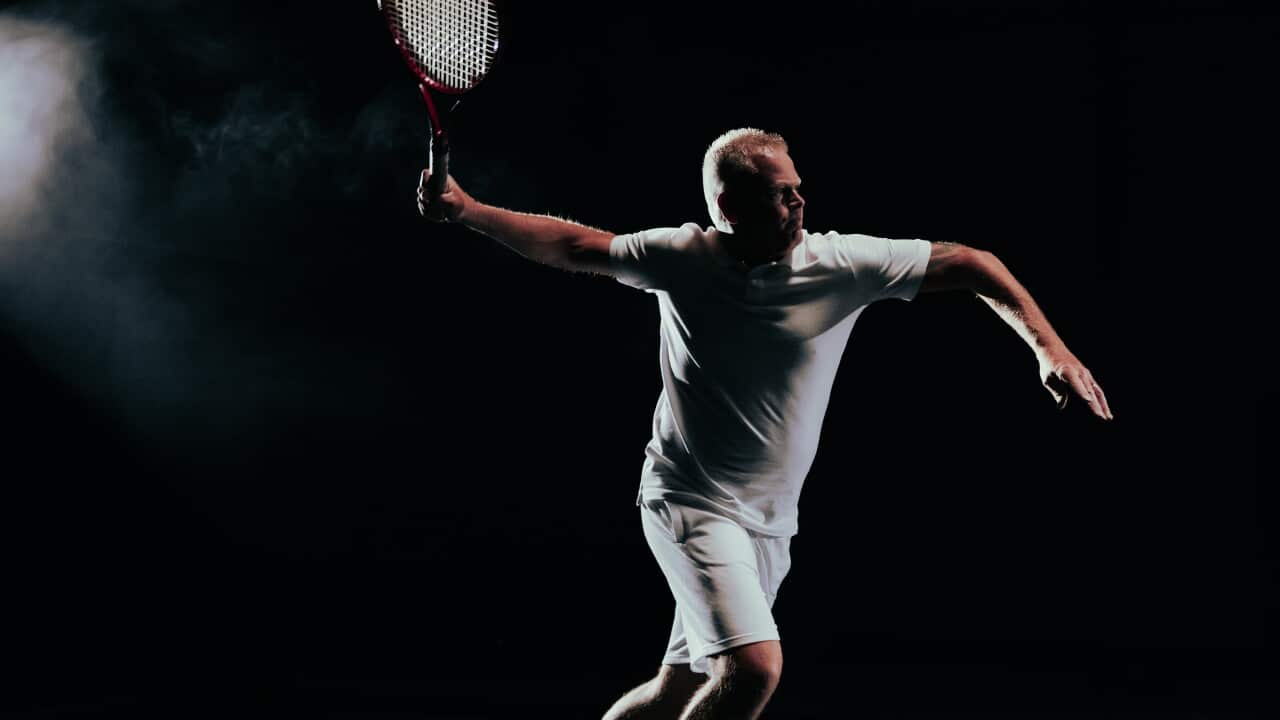Mick Leigh was a teenager when his vision and hearing began deteriorating.
He was in his 30s when he stepped away from a job in the building industry and gave up his driver's licence.
Now 44, with tunnel vision, he's getting ready to play the Australian Open’s first-ever exhibition game of blind and low-vision (BLV) tennis on 23 January. He’s one of eight players who will be competing on the day.
Mick is hoping the sport's Australian Open debut will propel the game forward and echo the popularity wheelchair tennis has enjoyed in recent years.

Low-vision tennis player Mick Leigh, 44, said his introduction to the sport gave him a sense of connection and independence. Source: Supplied
"Tennis has just changed my life a lot. It's given me some independence back."
The enjoyment, independence, and social connection he gets from playing are aspects he wishes to share.
How is blind and low-vision tennis played?
The game looks fairly similar - but it sounds different. Often, it’s called “soundball”.
Like tennis for sighted people, the game requires quick feet, focus, and precise angles. For many with low to no vision, it relies heavily on their ears.
Players follow the sound of an adapted foam ball rattling across the court. The sound helps them to keep their bearings. Courts are smaller, and for tennis matches with blind players, lines on the court are raised to mark certain boundaries.
For those with no sight, up to three bounces are allowed on their side of the court. For those with low vision, one or two bounces are allowed depending on their sight classification.
For completely blind players, a blindfold (or blocked-out glasses) is worn while playing. Balls last just two games, deteriorating from the force of the hits, and the wind is a big consideration for a game of BLV tennis. With a foam ball easily affected by a breeze, it's a game best played indoors.
Blind and low-vision players can, of course, play with sighted players with the adjustments.
Lack of understanding of disability in sports persists
Nineteen-year-old Courtney Webeck will also be playing on 23 January, having just won the National BLV Championships in Victoria last October.
"It's not all that different, it's still as physically, mentally, and practically challenging as the able-bodied game of tennis - just pretty much with a different ball," she told The Feed.
With that said, she adds, "I don't think people really take seriously the way we play."

Courtney Webeck, 19, is one of the eight blind or low-vision players who will make their Australian Open debut on 23 January. Source: Supplied
Also in the research, three-quarters of Australians said awareness and major events had the power to make people living with a disability feel included.
"People who I've talked to are curious, they want to learn about it. They've shown an interest," said Courtney.
For Blind Sports Australia CEO Matt Clayton, the biggest takeaway was that two-thirds of respondents living with a disability answered that they believe Australians do not fully understand their disability.
Travel and sourcing adapted equipment are among the obstacles which can sometimes add difficulty to the sport. Obstacles that aren't always appreciated.
"Obviously for most people who are blind or visually impaired or have low vision, travel isn't just jumping in a car, it's getting into a taxi, it's jumping on a train, or allowing another person to help you get there."
Another hurdle the sport faces is the availability of the adapted ball. With a ball only lasting a couple of games, it can be costly, especially with no manufacturer producing the ball in Australia.
"You can imagine the cost involved," Mr Clayton said. "But the more we showcase the sport and the more it grows, the more that costs obviously come down. More people get involved, and there's greater awareness around that equipment as well."
'Tennis among the most inclusive sports'
It's not just the growth of wheelchair tennis that has given tennis an inclusive image.
The Australian Open this year is hosting the first-ever international Persons with Intellectual Impairment and Deaf and Hard of Hearing Tournament – to be played on the final three days of the calendar. It hopes to have a blind and low-vision tournament ready by next year.
Other tennis associations along the circuit are also looking to implement BLV tennis games this year, a spokesperson from the Australian Open told The Feed.
It is also holding an 'All Abilities Day' to champion the adaptive forms of tennis and promote this year's additions, saying it's '#Open4All'.
For the first time ever, 'Action Audio' will be introduced, helping vision-impaired people experience matches in real-time, with audible descriptions of ball speed, trajectory, and placement.

Dylan Alcott playing for Australia. Blind and low-vision tennis hopes to recreate the growth Wheelchair Tennis has seen in recent years. Source: AAP / AAP
"I think for a long time we talked about the isolation of people with disabilities, and mainstream never really understood what that meant until the lockdowns happened," Mr Elbourn said.
"After everyone was isolated people now have a much greater appreciation when we're talking about solutions."



